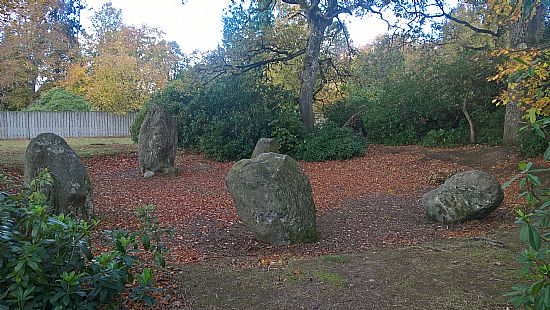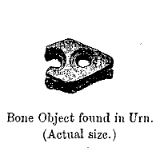Eight Stones or Fewer
Added on 05 March 2019

The oldest artefact in our area, thus found, is the stone circle in Druid’s Park.
Perhaps 5,000 years old. Little wonder then that it is a bit gappy. By contrast the present, ongoing, development of its surroundings as a housing estate is only into its third decade.
The circle has five stones, but space for eight. Just recently someone approached me with the accusation that Begg the Builder’s men had somehow broken the circle and removed some of the stones. When they were building those new houses virtually on top of it, landscaping with heavy machinery, or cutting and dragging away the rhododendrons which had all but buried it in the years of neglect following the Asylum's closure in 1986. Such notions and rumours about the builders have grown, as they are almost bound to with a whole community now living in the Park. While their gardens are maturing, kids growing up and already off to university, houses are still going up: three now in various stages of completion; three more still to be started.
At least three. That the cricket pitch might yet be built upon is a dripping roast for rumour mongers. Stranger things have happened. The oddly institutional looking care-home style building opposite Kinclaven Crescent, for example. No one guessed its true purpose, despite months of speculation; few could believe the truth, that it was actually a starter home wedding present for the builder’s son. Just as odd was the half built garage - with what looked like a huge upturned boat for a roof - to accompany the house on the edge of MacDuff Way. That suddenly vanished, only to reappear, finished, complete with external spiral staircase, as the centrepiece of the sewage works serving the estate.
I think the phrase people readily plucked with regard to ‘the builders’ still with them, still zanting around in JCBs, still clanking up and down to that mysterious, fenced off area near the river where they have dug a hole big enough to drop a church in is . . . ‘Capable of anything.’
However, they are off the hook with regard to the missing stones.
A circle of five stones was definitively recorded by the OS in its 2nd Edition map of Perth & Clackmannan, published in 1901. Actually, it probably made the 1st Edition of 1867 . . . but got obscured by a draughtsman's error. Less obviously, in terms of public access, is that the circle is clearly marked as containing five ‘Druidical Stones’ on the ‘Plan of Part of the Estate of Murthly Acquired by the Perthshire District Lunacy Board from Sir W. D. Stewart Bart'. Dated November 1859 (and in the private archive at the Castle). It's the only feature in the 60 acres of potato fields, scrub and moor sold to the Board by Sir William.
So that lets another, rather obvious suspect drop out of the frame. For the first time the land surrounding the stones was substantially developed was for Perth & District Asylum for Pauper Lunatics that opened across those 60 acres on 1st April 1964. Easy to assume the disturbance happened then, in those far off days. After all, the Victorians were renowned for building big, building fast, and building wholly unconstrained by today’s planning regulations concerning archaeological notification.
But they weren't barbarians. Although the ground was disturbed, however, and things were found.
The 'Druidical Stones' had stood for thousands of years in open ground. Then when the Asylum grounds were being landscaped, paths laid, shrubs and trees planted, it was decided to offer protection by including them within the large garden of the villa built as a grace and favour residence for the Medical Superintendent. In the process the circle was surrounded by a raised earthen mound. (Still a very obvious feature today.) At this point some cinerary urns were uncovered in groups of two and three, and even a series arranged in a circle. One urn was found at a distance from them, obviously a separate burial. It contained a few bones, partly burned, possibly those of a child, and a worked bone item. Dr William McIntosh, the Superintendent, sent them on to Arthur Mitchell M.D., a Commissioner in Lunacy, and secretary of the Society of Antiquaries of Scotland, along with a note saying none of the finds had been made within the circle itself. Mitchell eventually got round to writing up the results of his investigations for the Proceedings of the Society in 1872. He offered no date for the urns, but did note:
'So far as I am aware, this is the first instance in which a piece of worked bone has been found in a funereal  urn. What use this little bone implement served I cannot tell. It may have been the plaything of the child whose remains were buried in the urn, or a fragment of a bone button.'
urn. What use this little bone implement served I cannot tell. It may have been the plaything of the child whose remains were buried in the urn, or a fragment of a bone button.'
Who knows what might yet be found outside of the 60 acres, built in the yawning gap of time between the stones being hauled into place and the earliest attempts to map the area. The latter, by Timothy Pont, being barely 400 years old. A fort, possibly, that may account for the three missing stones, hauled off for another use? Since Pont we have a fairly clear record of how the land was used, and nothing fits the bill. Then again, little drones in dry summers are turning up evidence of lots of lost buildings and settlements across the country. Nevertheless, I am inclining towards the notion the circle was never completed. Perhaps Druid's Park old and new have that in common. Being incomplete.
.